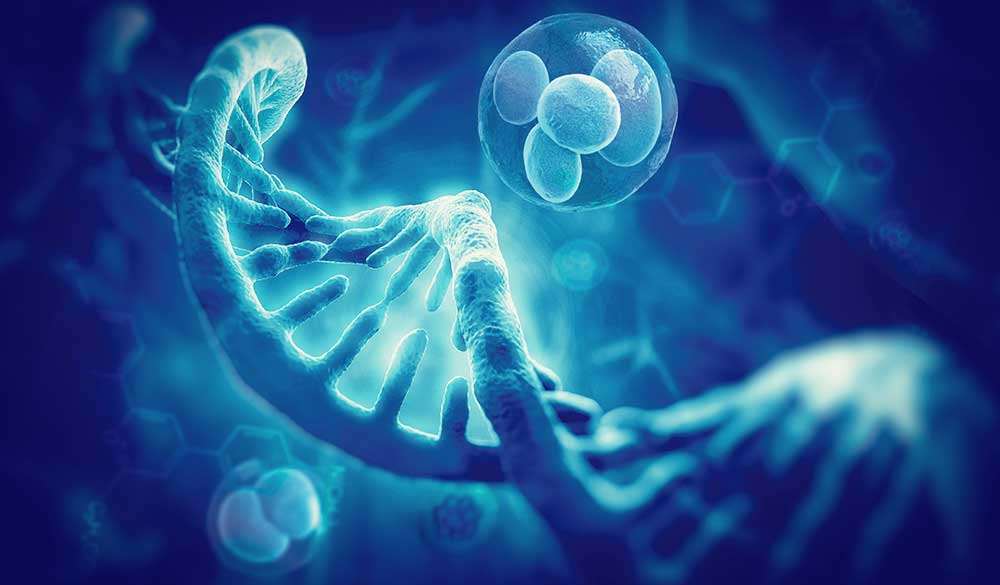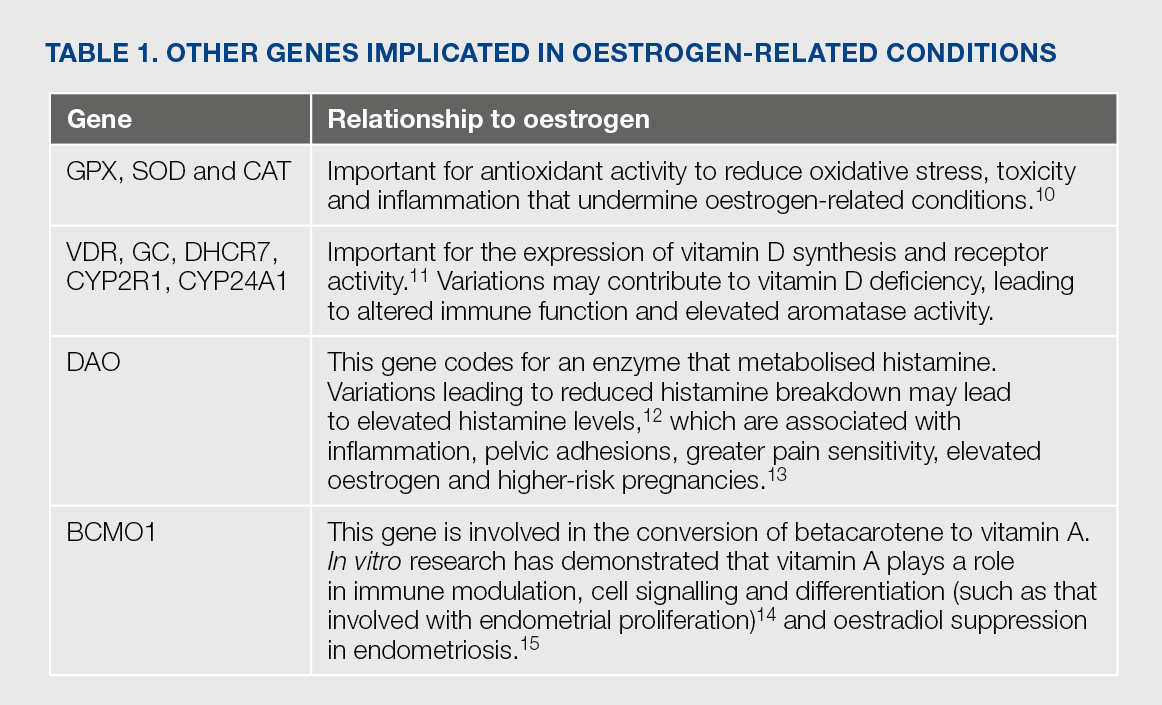Numerous genes are involved in the production, function and metabolism of oestrogen within the body. Understanding the influence of these genes is useful in the exploration of oestrogen-related conditions.
CYP19A1
CYP19A1 is a single gene that encodes the aromatase enzyme, which converts androgens to oestrogen.[1] For females, aromatase activity occurs primarily in the ovaries, where it guides sexual development.[1] Aromatase deficiency is characterised by reduced oestrogen and increased androgen levels. This imbalance in females leads to impaired sexual development, unusual bone growth, insulin resistance and other signs and symptoms.[1]
Conversely, for aromatase excess syndrome, increased oestrogen and reduced androgen levels may lead to irregular menstrual periods and short stature.[1]
CYP19A1 variations have been associated with conditions such as breast cancer, polycystic ovarian syndrome (PCOS), endometriosis and related infertility.[1-4]
COMT
The COMT gene functions to produce the catechol-O-methyltransferase enzyme,[5] which extrahepatically, is a key player in the inactivation of catechol oestrogens, 2- and 4-hydroxyoestradiol.[5] The latter of the two, 4-hydroxyoestradiol in particular, has been implicated in the onset of cancer as it can be oxidised to oestrogen-3,4-quinones, which may react with DNA. As a result, COMT may play a role in oestrogen-dependent cancers due to its ability to inactivate oestrogen metabolites, therefore lowering the levels of these potential carcinogens.[6]
NQO1
NADPH quinone oxidoreductase 1 (NQO1) is an enzyme encoded by the NQO1 gene, which is an important gene in the metabolism of oestrogen as it has the capacity to reduce catechol oestrogen quinones back to catechol oestrogens. Along with COMT, NQO1 is a key deactivating enzyme in the reduction of catechol oestrogen quinones that react with DNA, initiating the series of events that lead to breast cancer.[7]
PGR
PGR genes encode the progesterone receptors, which mediates the physiological effects of progesterone. Progesterone plays a pivotal role in reproduction and the establishment and maintenance of pregnancy.[8] Variations in this gene may affect endometrium quality and it has been associated with an increased risk for endometriosis[9] as well as issues with infertility and early abortions.[8]
The science of genetic medicine is forever expanding with the identification of new genes, variations and their implications in pathology. The genes mentioned previously represent just a small handful of what is essentially the human galaxy of genetics. And while the understanding of these genes is insightful, it is not necessarily diagnostic. It is important to follow up genetic testing with the appropriate investigations for proper diagnosis.
References
- Genetics Home Reference. Your guide to understanding genetic conditions: CYP19A1 gene. US National Library of Medicine, 2014. [Source]
- Wang H, Li Q, Wang T, et al. A common polymorphism in the human aromatase gene alters the risk for polycystic ovary syndrome and modifies aromatase activity in vitro. Mol Hum Reprod 2011;17(6):386-391.[Abstract]
- Tuo Y, He JY, Yan WJ, et al. Association between CYP19A1, GSTM1, GSTT1, and GSTP1 genetic polymorphisms and the development of endometriosis in a Chinese population. Genet Mol Res 2016;15(4). doi:10.4238/gmr15048837. [Abstract]
- Barcelos ID, Donabella FC, Ribas CP, et al. Down-regulation of the CYP19A1 gene in cumulus cells of infertile women with endometriosis. Reprod Biomed Online 2015;30(5):532-541.[Abstract]
- Genetics Home Reference. Your guide to understanding genetic conditions: CYP19A1 gene. US National Library of Medicine, 2007. [Source]
- Schendzielorz N, Rysa A, Reenila I, et al. Complex estrogenic regulation of catechol-O-methyltransferase (COMT) in rats. J Physiol Pharmacol 2011;62(4):483-490.[Abstract]
- Singh S, Chakravarti D, Edney JA, et al. Relative imbalances in the expression of estrogen-metabolizing enzymes in the breast tissue of women with breast carcinoma. Oncol Rep 2005;14(4):1091-1096. [Abstract]
- Genetics Home Reference. Your guide to understanding genetic conditions: PGR gene. US National Library of Medicine, 2018. [Source]
- Meyer JL, Zimbardi D, Podgaec S, et al. DNA methylation patterns of steroid receptor genes ESR1, ESR2 and PGR in deep endometriosis compromising the rectum. Int J Mol Med 2014;33(4):897-904. [Abstract]
- Ighodaro OM, Akinloye OA. First line defence antioxidants-superoxide dismutase (SOD), catalase (CAT) and glutathione peroxidase (GPX): Their fundamental role in the entire antioxidant defence grid. Alex J Med 2017; doi.org/10.1016/j.ajme.2017.09.001. [Source]
- Barry EL, Rees JR, Peacock JL, et al. Genetic variants in CYP2R1, CYP24A1, and VDR modify the efficacy of vitamin D3 supplementation for increasing serum 25-hydroxyvitamin D levels in a randomized controlled trial. J Clin Endocrinol Metab 2014;99(10):E2133-E2137. [Full Text]
- Maintz L, Novak M. Histamine and histamine intolerance. Am J Clin Nutr 2007;5(1):1185-1196. [Abstract]
- Maintz L, Schwarzer V, Bieber T, et al. Effects of histamine and diamine oxidase activities on pregnancy: a critical review. Hum Repro Update 2008;5(10):485-495. [Abstract]
- Genetics Home Reference. Your guide to understanding genetic conditions: BCo1 gene. US National Library of Medicine, 2018. [Source]
- Saxena M. Pain related genes in endometriosis: a meta-analysis. A thesis submitted to the Sydney Medical School in fulfilment of the requirement for the degree of Master of Philosophy in Science, 2015. [Source]
DISCLAIMER:
The information provided on FX Medicine is for educational and informational purposes only. The information provided on this site is not, nor is it intended to be, a substitute for professional advice or care. Please seek the advice of a qualified health care professional in the event something you have read here raises questions or concerns regarding your health.





